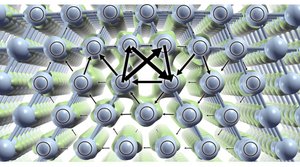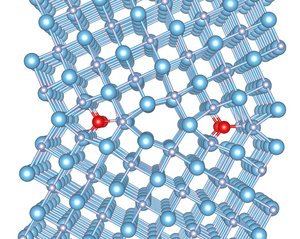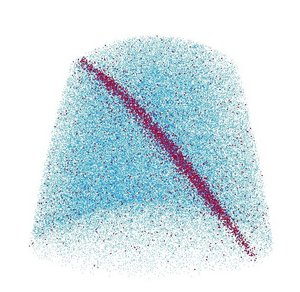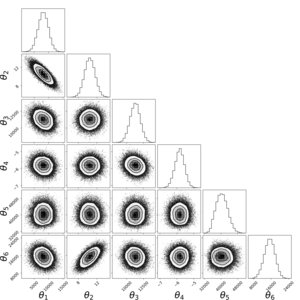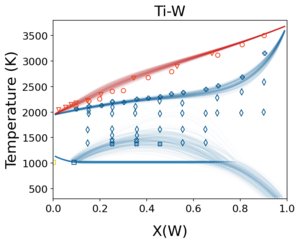Research group Romaner
Research activities target the simulation of materials properties in particular the design of crystallographic defects including dislocations, grain boundaries and metallic surfaces as well as the investigation of interaction of molecules with metallic surfaces. A central aspect is to understand how changes in chemical composition affect atomic- scale quantities and their consequences for overall material behavior.
Dislocations
An important topic is the understanding of core structures of dislocations in bcc metals, where atomistic simulations reveal the impact of alloying on the dislocation core, Peierls stress or glide plane. Such simulations provide insights into the basic mechanisms of plastic deformation and allow deriving trends for strength and ductility of crystalline materials.
For further reading see:
- L. Romaner, T. Pradhan, A. Kholtobina, R. Drautz, and M. Mrovec, “Theoretical investigation of the 70.5° mixed dislocations in body-centered cubic transition metals,” Acta Mater., vol. 217, 2021.
- A. S. Kholtobina, R. Pippan, L. Romaner, D. Scheiber, W. Ecker, and V. I. Razumovskiy, “Hydrogen trapping in bcc iron,” Materials (Basel)., 2020, doi: 10.3390/ma13102288.
- H. Li, C. Draxl, S. Wurster, R. Pippan, and L. Romaner, “Impact of d-band filling on the dislocation properties of bcc transition metals: The case of tantalum-tungsten alloys investigated by density-functional theory,” Phys. Rev. B, vol. 95, no. 9, 2017, doi: 10.1103/PhysRevB.95.094114.
- L. Romaner, V. I. Razumovskiy, and R. Pippan, “Core polarity of screw dislocations in Fe-Co alloys,” Philos. Mag. Lett., 2014, doi: 10.1080/09500839.2014.904055.
- H. Li, S. Wurster, C. Motz, L. Romaner, C. Ambrosch-Draxl, and R. Pippan, “Dislocation-core symmetry and slip planes in tungsten alloys: Ab initio calculations and microcantilever bending experiments,” Acta Mater., vol. 60, no. 2, pp. 748–758, Jan. 2012, doi: 10.1016/j.actamat.2011.10.031.
- L. Romaner, C. Ambrosch-Draxl, and R. Pippan, “Effect of Rhenium on the Dislocation Core Structure in Tungsten,” Phys. Rev. Lett., vol. 104, p. 195503, 2010.
- G. Schoeck and L. Romaner, “Deviations and polarity of [100] dislocations in bcc metals,” Philos. Mag. Lett., vol. 90, no. 6, 2010, doi: 10.1080/09500831003680760.
Interfaces
Atomistic simulations of interfaces allow investigating their structural properties, energetics and chemical composition. A strong focus is laid on understanding of solid state segregations which are investigated by coupling atomistic simulations and thermokinetic modelling. Close validation is possible with atom probe tomography measurements which are also carried out at the Department.
For further reading see:
- A. Ahmadian et al., “Aluminum depletion induced by co-segregation of carbon and boron in a bcc-iron grain boundary,” Nat. Commun., vol. 12, no. 1, 2021.
- D. Scheiber, L. Romaner, R. Pippan, and P. Puschnig, “Impact of solute-solute interactions on grain boundary segregation and cohesion in molybdenum,” Phys. Rev. Mater., vol. 2, no. 9, 2018.
- K. Leitner et al., “How grain boundary chemistry controls the fracture mode of molybdenum,” Mater. Des., vol. 142, pp. 36–43, 2018, doi: 10.1016/j.matdes.2018.01.012.
- D. Scheiber, R. Pippan, P. Puschnig, and L. Romaner, “Ab initio calculations of grain boundaries in bcc metals,” Model. Simul. Mater. Sci. Eng., vol. 24, no. 3, p. 035013, 2016, doi: 10.1088/0965-0393/24/3/035013.
- D. Scheiber, V. I. Razumovskiy, P. Puschnig, R. Pippan, and L. Romaner, “Ab initio description of segregation and cohesion of grain boundaries in W–25 at.% Re alloys,” Acta Mater., vol. 88, pp. 180–189, Apr. 2015, doi: 10.1016/j.actamat.2014.12.053.
- V. I. Razumovskiy, S. V. Divinski, and L. Romaner, “Solute segregation in Cu: DFT vs. Experiment,” Acta Mater., vol. 147, pp. 122–132, 2018, doi: 10.1016/j.actamat.2018.01.011.
- D. Scheiber, O. Renk, M. Popov, and L. Romaner, “Temperature dependence of surface and grain boundary energies from first principles,” Phys. Rev. B, vol. 101, p. 174103, 2020, doi: 10.1103/PhysRevB.101.174103.
Data-driven modeling methods
The aim is to develop hybrid modelling methods for materials science phenomena. This includes application of ML modelling methods to train on results obtained from DFT calculations in order to make predictions computationally more efficient. Furthermore, the activities involve building up of databases of materials properties. For example we are in process to create databases foo grain boundary chemistry the FWF project P 34179 “Hybrid Modeling of Grain Boundary Chemistry”. A further application of data-driven methodology is creation of CALPHAD assessments where we aim to combine DFT data and experimental data for predictive simulation of thermodynamic properties of materials.
For further reading see:
- Christoph Dösinger, Tobias Spitaler, Alexander Reichmann, Daniel Scheiber, Lorenz Romaner., „Applications of Data Driven Methods in Computational Materials Design“, BHM, 168, 1, 2022
- M. N. Popov, J. Spitaler, L. Romaner, N. Bedoya-Martínez, and R. Hammer, “Bayesian Optimization of Hubbard U’s for Investigating InGaN Superlattices,” Electron. Mater., vol. 2, no. 3, pp. 370–381, Aug. 2021, doi: 10.3390/electronicmat2030025.

